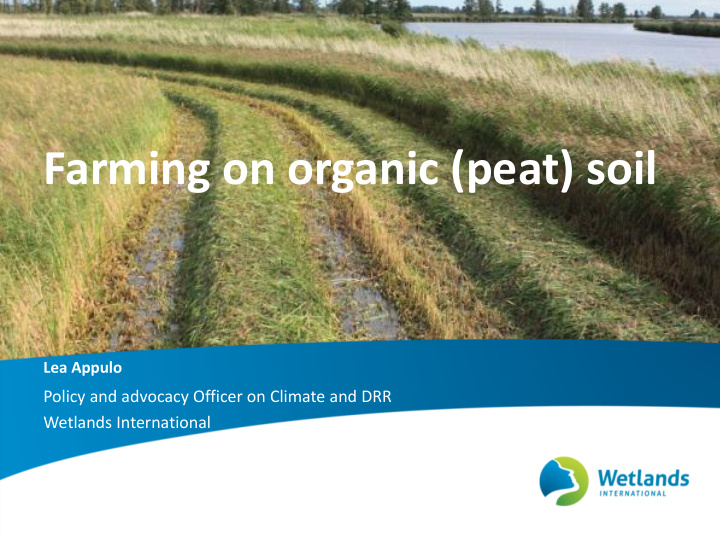



Farming on organic (peat) soil Lea Appulo Policy and advocacy Officer on Climate and DRR Wetlands International
Peat soils: Lands with a peat layer at the surface • Peat has accumulated when the soil was permanently waterlogged and dead plant remains did not completely decompose • Peat contains a large proportion of organic carbon
Conventional agriculture on peatland: Drainage → peat mineralises and shrinks Van de Riet et al. 2014
Conventional agriculture on peatland: Drainage → peat mineralises and shrinks Van de Riet et al. 2014
Conventional agriculture on peatland: Drainage → peat mineralises and shrinks Van de Riet et al. 2014
The deeper the drainage, the higher the emissions… Conventional peatland use Couwenberg et al. in prep./GMC emission database
Is it a problem at European scale?
Yes - organic soils occur in all European countries ‚ Organic soil ‘ definition after IPCC: Lands with a peat layer at the surface. Tanneberger et al. (2017)
Yes - organic soils occur in all European countries 26 % 21 % 4% Tanneberger et al. (2017) % of the national land area
In many countries, the majority of the peat soil is d rained! 61 % 82 % 98 % Tanneberger et al. (2017) % drained of total organic soil
They are drained for agriculture, forestry or peat extraction
How is it possible that this problem has been overlooked for so long?
Peatlands are not recognized: the Cinderella syndrome China
Paradigm over millenia: Productive land must be dry… Iceland
… and agricultural soils must be repeatedly moved. Germany
Assumptions that we apply, for example, by cultivating semi-arid maize on drained peatland Germany
Because of the CO 2 from the peat, ‘biogas’ from maize on peat causes 8x more climate damage per joule energy than burning lignite…
Drainage-based land use on peatlands should be phase out
What we also know: Peatland rewetting… Drained peat Wet peat Van de Riet et al. 2014
…stops subsidence + emissions Drained peat Wet peat Wet peat Van de Riet et al. 2014
Peatland rewetting Emission reduction Conventional Paludiculture peatland use → peat is preserved at groundwater tables close to soil surface Couwenberg et al. in prep./GMC emission database
Paludiculture - the wet alternative ‚ palus ‘ → Latin for swamp ‚ culture ‘ → agriculture or forestry Paludiculture is the productive use of wet peatlands. First used by Joosten (1998)
Paludiculture plants Plants that can be grown under permanently wet conditions and supply usable above-ground biomass without detriment to the peat body and its carbon reservoir. → ~300 plant species with good potential in Europe GMC Database of Potential Paludiculture Plants (DPPP)
Paludiculture types Wet meadows/ Cropping pastures paludicultures Foto: A. Schäfer
Sedges ( Carex spp.) – wet meadows Productivity: 3-12 t DM/ha/yr
→ for energy (combustion, biogas), fodder
Water buffalo – wet pastures Productivity: 840 g/day/calf
→ for beef production, habitat management
Common Reed ( Phragmites australis ) productivity: 3 – >25 t DM/ha/yr
→ for construction material, energy
Market of thatching reed Demand in EU: ca. 15 Mio bundles per year → import rate c. 80% Wichmann & Köbbing (2015)
Cattail ( Typha spp.) Productivity : 5-22 t DM/ha/yr
→ for construction materials, insulation, fodder
Alder ( Alnus glutinosa ) Productivity: 3-10 t DM/ha/yr
→ for furniture
Peatmosses ( Sphagnum spp.) Productivity: 2-9 t DM/ha/yr
Sphagnum farming on former drained peatland → site preparation + → established culture Initial state seeding May 2011 November 2011
→ for horticultural substrate (similar properties like peat)
Additional ecosystem services • reduced nutrient run-off = water purification • decreased evapotranspiration = landscape cooling • increased flood protection • Increased groundwater storage • often increased biodiversity
Selected paludiculture demonstration & pilot sites in Europe Wet meadows/pastures : Demonstration sites in several countries (often within nature conservation schemes) Cropping paludicultures : Pilot sites in UK, NL, DE (research projects) On rewetted peatland: < 2 km 2
THANK YOU For info: lea.appulo@wetlands.org
Recommend
More recommend